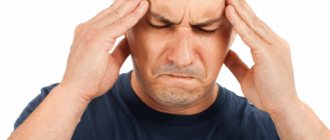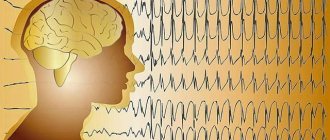Pain in the eye and forehead area occurs quite often. This phenomenon has happened to almost everyone. Pain and pain may be accompanied by other alarming symptoms: vomiting, dizziness, etc. Sometimes the discomfort goes away without taking medication: just rest and rest is enough. However, if the pain does not go away over time, then medical attention and treatment will most likely be required.
Causes of discomfort
Often headaches and nausea are accompanied by other unpleasant symptoms:
- dizziness;
- abdominal pain;
- general weakness;
- heat;
- eye pain;
- noise in ears;
Depending on the accompanying symptoms, it is necessary to identify several diseases that lead to nausea and headaches.
Migraine
Patients usually describe their condition as follows: a throbbing pain appears in one part of the head, as if someone had poked them with a burning stick. It radiates into the ear, eye, temples. With bright light and sharp sounds, the discomfort intensifies. Over time, the headache hurts to the point of nausea, vomiting, and the person cannot do anything.
Experts have not identified the exact causes of migraine; attacks can appear once a week or not bother a person for years. The duration of a migraine attack can range from two hours to three days.
Hormonal changes
Hormonal changes in the human body can provoke headaches and nausea. Patients complain of these symptoms:
- adolescence during puberty;
- pregnant women;
- girls with premenstrual syndrome;
- women of climatic age.
Treatment of headaches in the forehead and eyes
Physiological and pathological conditions that are accompanied by pain in the head and eyes often have additional specific symptoms. Some patients constantly have pain in a certain part of the skull, for others it is difficult to determine the localization of the symptom, for others it is difficult to even move their eyeballs.
The type of sensations, frequency and time of their occurrence, duration - all this helps the doctor when making a diagnosis. Systematic or prolonged attacks of eye pain and headache are usually accompanied by a number of striking clinical manifestations.
Some of them affect the human psyche or lead to a decrease in the quality of his life.
The cause of pain is intracranial hematoma
Any head injury can lead not only to a concussion, but also to a complication - intracranial hematoma. So if you have headaches due to an injury, you need to go to the doctor as quickly as possible, where you should get a brain tomogram, this will help detect a hematoma at its earliest stage. If the diagnosis is confirmed, prompt surgical intervention will be required.
In case of a concussion, the doctor determines the severity of the injury and prescribes medications to strengthen blood vessels, as well as gives recommendations for the regimen. This includes mandatory refusal of any physical activity and complete rest.
Relief from discomfort at home
Not every person immediately consults a doctor if he has a headache, nausea, or dizziness. If unpleasant symptoms are caused by poisoning, a cold, or osteochondrosis, you can eliminate the discomfort at home.
The patient can take painkillers:
- analgin;
- citramon;
- ibuprofen;
- spasmalgon.
In order to avoid pain in the future after work, you need to do a little exercise and change your body position during monotonous activities. It is recommended to engage in sports, such as swimming, and undergo a massage to restore muscle mobility.
If you have a headache in the evening and feel a little nauseous after work, you need to lie down and rest for a few minutes. Sometimes it is enough to lie in silence for 15 minutes for the discomfort to subside without medications.
Are the discomfort caused by a hangover? To eliminate nausea, you need to drink Activated carbon - 1 tablet for every 10 kg of weight. To relieve headaches, it is recommended to take 2 Aspirin tablets.
What to do if headaches and nausea are caused by hormonal changes, migraines? If discomfort appears before menstruation, it is enough to take a painkiller. A migraine attack can be relieved with special medications:
- sumamigren;
- triptan;
- ergotamine.
Some patients benefit from a warm shower or a short walk in the fresh air. For rare nerve pain, when painful sensations appear, soothing teas are used for treatment:
- chamomile;
- with mint;
- St. John's wort;
- lemon balm;
- oregano.
To eliminate the discomfort caused by hypertension, you need to take a medicine that lowers blood pressure.
Treatment
Sometimes treating a headache means treating the underlying disease that caused it:
| Cause of headache | Treatment |
| Flu | Take antipyretics (paracetamol) and antivirals (Arbidol, Kagocel), which, among other things, relieve heaviness and pain |
| Sinusitis | Drink antibiotics (exclusively as prescribed by a doctor) and remove purulent contents from the paranasal sinuses |
| Osteochondrosis | Give a massage, prescribe non-steroidal anti-inflammatory drugs (diclofenac) |
| Eye strain and fatigue | Prevention is important - you need to periodically rest, do eye exercises, and use artificial tears. If headaches reduce quality of life, you can take analgesics or non-steroidal anti-inflammatory drugs (ibuprofen) |
| Allergy | In case of an allergic reaction, take antihistamines - Histafen, Claritin |
For migraine
Migraines are the most difficult to treat. Doctors still do not know the exact causes of this condition. Research has found that migraine attacks in women are associated with hormonal changes. Then pain occurs only in the first two or three days of the cycle, and then it disappears for a long time.
But there are people whose migraine attacks are caused by stress, hunger, dehydration, and lack of sleep. Weekend migraines are also identified; they are caused by excessive sleep. The problem is provoked by certain products - chocolate, hard cheese, wine.
To get rid of migraine headaches, you need:
- 1. Eliminate all the factors listed above.
- 2. Review your daily routine so as to ensure proper rest and timely meals.
- 3. Eliminate other risk factors - excess weight and physical inactivity, that is, a sedentary lifestyle. Moderate physical activity in this case is very useful.
Although migraine cannot be completely cured, it can be successfully controlled. First of all, with medications. Although an attack can usually be relieved with ibuprofen or another non-steroidal anti-inflammatory drug, specific medications such as triptans and ergotamine are considered more effective.
Sometimes they are prescribed in combination with each other. If the patient feels nauseous during an attack, the doctor prescribes antiemetic drugs. They are needed not only to relieve nausea, but also to help other medications be better absorbed.
All medications must be taken strictly in the dosage prescribed by the doctor. It is important to drink them with plenty of water, but in no case with tea, coffee or fruit juices. All medications should be taken at the very beginning of the attack; there is no need to wait until the pain reaches full strength.
Doctors often prescribe migraine preventatives that can be taken daily, outside of attacks of the disease. These are some antidepressants and antiepileptic drugs. Botulinum toxin injections are used, and in fairly high dosages. Sometimes even several such courses are required.
Headache and pressure on eyes - what to do?
Doctors give an impressive list of reasons. In most cases, timely initiation of treatment allows you to quickly and completely get rid of the unpleasant syndrome.
The main thing is not to delay going to the doctor, not to try to solve the problem with the help of painkillers and not to get carried away with traditional medicine without the permission of a specialist.
Overwork
In this case, blurred vision and decreased visual acuity are observed, pain is localized in the temples and back of the head. Red eyes appear dry or, on the contrary, become very watery. If you ignore the condition, it will be accompanied by general weakness, weakness, dizziness and nausea.
Migraine
The number of people who are familiar first-hand with such a problem as regular headaches of varying localization and intensity is only growing every year. Today, complaints about frequent headaches and pressure on the eyes have become commonplace.
A headache with noticeable pressure on the frontal, temporal region and eyes can serve as a symptom of a whole complex of diseases, for example, dental problems, inflammation of the sinuses, allergic manifestations, migraines, etc.
Features of headaches
There are a variety of reasons that cause migraines and unpleasant blood pressure. A headache, usually as a result of excessive physical, mental or moral stress, with severe fatigue.
A feature of most headaches is their long-lasting nature. Often it is not possible to reduce the pressure on certain areas of the head and eyes even after identifying the root cause of the painful condition.
It is for this reason that people who, due to their occupation, have to work under conditions of severe mental and mental stress, rarely manage to avoid the appearance of chronic headaches.
Be that as it may, a condition where there is a headache and pressure on the eyes should not be ignored, leaving everything to chance, since over time this inevitably leads to the development of neuroses and depressive states, which are quite difficult to treat.
What is migraine?
Migraine is one of the forms of headache, which is characterized by a rather vivid clinical picture. Among the typical symptoms that usually precede a migraine attack are:
- creeping nausea, gag reflexes, increasing dizziness;
- speech disorder;
- numbness of the limbs;
- the appearance of luminous colored objects in the field of view;
- heightened awareness of certain senses, such as smell, sound, or perception of light;
In medical practice, the above manifestations are known as migraine aura. The complex symptoms of migraine are complemented by headaches and pressure on the eyes, as well as unpleasant sensations in the forehead and temples. People who are familiar with migraine attacks most often characterize their own condition as unbearably painful and even painful.
Despite the fact that modern medicine has made significant strides in the treatment of headaches, the main causes of migraine development are still not fully understood. However, it is known for sure that migraine is hereditary and also manifests itself under the influence of a number of external negative factors.
Headache - what to drink?
For severe, regular headaches, experts often recommend taking non-steroidal anti-inflammatory medications, for example, those containing ibuprofen. By the way, ibuprofen leads to a noticeable inhibition of symptoms and relief of headache attacks.
For migraines, the effect of the substance on the body causes relief of gag reflexes, elimination of photosensitivity, nausea and general anxiety.
If we talk about traditional medicine, painkillers come first here. A specialist can recommend a list of medications that are most effective in combating headaches. Therefore, when looking for optimal ways to quickly relieve pain, it is better not to engage in amateur activities and trust the doctor’s recommendations.
Painkiller tablets - list
- Paracetamol is effective for mild to moderate headaches. Contraindication for use is liver dysfunction. It relieves pain well, but nausea is a common side effect.
- The medicine Migrenol is an excellent remedy for people who are deprived of healthy sleep as a result of migraines and serious, prolonged attacks of headaches. It has its own analgesic effect, and also enhances the effect of paracetamol, acting as a combination drug.
- The drug Solpadeine contains the active substances caffeine and codeine, which significantly enhance the effect of taking simple analgesics. Along with its analgesic properties, the drug is an excellent cough remedy.
- The medication Analgin has an enhanced analgesic effect. In addition to treating headaches, it is often used for fever and toothache.
- Tempalgin is an antispasmodic drug that enhances the effect of metamizole sodium on the body, which helps relieve the negative effect and consequences of pain syndromes.
What to do if you have a headache: general tips
Headaches can cause serious complications in your overall well-being and comfortable existence in general. Many people use specific methods to relieve pain in the head area.
In particular, taking a contrast shower, putting a wet towel on your forehead, or resting in a special position can serve as a salvation when you have a headache and pressure on your eyes. However, despite the proven nature of these methods, they cannot help everyone.
Therefore, along with taking medications, it is necessary to find your own ways that can reduce the symptoms of pain.
Currently, there are a sufficient number of medications that eliminate pain in the head within a matter of minutes. Therefore, if you have regular, systematic headaches, it is recommended to consult a professional osteopath. It is likely that the doctor will be able to identify the root cause of the headaches, after which the appropriate medications will be prescribed.
Headache is an unpleasant phenomenon that can be accompanied by many different symptoms and have a varied nature. A common example of this is a headache that creates a feeling of pressure on the eyes. The reasons that cause it, and accordingly, the treatment methods vary significantly.
Vascular causes
Migraines can cause pain of almost any nature. Considering that most people have it, the likelihood that you have a headache and pressure on your eyes for this reason is quite high. A characteristic feature of migraine pain is its one-sided nature. The pain is very intense, throbbing or dull, intensifying in the eye area.
You can distinguish a migraine from another type of pain because during an attack you feel nauseous, vomiting may or may not be present. The sharpness of vision deteriorates significantly, there is very strong photophobia and tinnitus.
Treatment for migraine has not yet been fully developed, nor have the reasons why it occurs been established. The best solution for such a patient would be to avoid stress and get more rest and eat right. This will reduce the likelihood of an attack.
Hypertension is also characterized by pressing pain in the head. Most often they are felt in the back of the head, but the pressure is concentrated specifically in the eyes.
Depending on the stage of development of hypertension, the headache may be severe or not too severe. At the same time, nausea without vomiting, swelling and redness of the face, dizziness and tinnitus are observed.
Treatment should be prescribed by a doctor and aimed at eliminating the cause, that is, fighting hypertension.
Cerebral aneurysm is one of the most serious reasons why there is headache and pressure in the eye area. This pain is characterized by high intensity and is localized in the same area.
It has a pulsating character. An aneurysm requires surgery, and therefore it is necessary to consult a doctor for research and an accurate diagnosis.
ENT diseases
This is a fairly wide variety of diseases and all of them can cause intense or aching pain in the head with a feeling of pressure on the eyes. Untreated otitis media, in particular, is characterized by the fact that a large amount of pus accumulates in the middle ear area. This causes severe headaches in the area behind the ear, and sometimes in the entire half of the head (in the most advanced stages).
In this case, due to general swelling in the area behind the eye on the same side, strong pressure may be observed. The pain in this case is characterized by high intensity, pulsating, sometimes shooting. Actually, the ear may not hurt.
Sinusitis is a common disease that causes the symptoms discussed. Pus accumulates in the maxillary sinuses and swelling increases. As a result, pain is felt in their area, which intensifies with palpation and tilting the head. They are not too intense, but quite noticeable and cannot be relieved by painkillers.
Sinusitis develops as a result of lack of treatment for ordinary rhinitis. The outflow of mucus is disrupted due to edema, and inflammation develops. This occurs after about 10 to 14 days of rhinitis or sinusitis.
Frontal sinusitis is a disease similar to sinusitis, but inflammation occurs not of the maxillary sinuses, but of the frontal sinuses in the frontal lobe. The accumulation of pus in these sinuses is extremely rare, but pain and pressure are felt due to swelling.
In this case, pain is observed in the area between the eyebrows, has an aching character and intensifies when bending over. The pressing sensation on the eyes is concentrated in their upper part.
Usually, frontal sinusitis does not occur without sinusitis.
In case of all three diseases, the patient requires immediate medical treatment. An otolaryngologist may prescribe antibiotics. In some cases, surgical treatment cannot be avoided.
Brain changes
Useful video
This video shows what to do if you have a headache in the forehead and temples:
Obviously, headaches that radiate to the eyes are a very common symptom.
, therefore it is familiar to most people firsthand.
Despite its commonness, it is unacceptable to neglect the condition
. Perhaps the cause of the malaise is harmless, but it may also indicate serious disorders.
If there are no reasons for pain such as stress and lack of sleep
, but it doesn’t go away on its own,
you need to immediately contact a specialist
, forgetting about self-diagnosis and self-medication.
Modern life, with a lot of stress, worries and a lot of time spent at the computer, leads to the fact that very often our eyes and head hurt. This problem interferes with productive work and even negates rest. In addition, some diseases that cause headaches can even lead to heart attacks and strokes. Let's figure out why the head hurts along with the eyes and what to do about it.
The most common cause of headaches that radiate to the eyes is hypertension or high blood pressure. Pain in the eyes is associated with increased intraocular pressure.
Hypertension is, as a rule, an age-related disease, however, now with the increase in the speed of life and the massive introduction of computer technology, already 25% of young people suffer from high blood pressure. Sometimes this disease manifests itself during puberty due to a sharp hormonal surge in the body. Hypertension is often associated with overwork.
Migraine is another cause of headaches, usually in the temples, when the pain radiates to the eyes. Migraines may cause blurred vision and intolerance to bright light. The disease is also hereditary, transmitted mainly through the female line, and is quite dangerous - with repeated pain, it can seriously interfere with work and even lead to disability.
The main factors causing high blood pressure and migraines:
- smoking, especially in combination with alcohol
- drinking coffee or energy drinks
- taking large amounts of table salt
- taking medications, in particular, hormonal contraceptives by women
- poor sleep hygiene - sleep significantly less or more than 8 hours
- heavy, and most importantly, irregular physical activity
- spending a lot of time at the computer
- obesity
- lack of walks in the fresh air
- stress
- mental and mental stress
- sudden change in weather
Cervical osteochondrosis is another disease in which headaches radiate to the eyes. An artery supplying blood to the brain passes through the neck area; when it is compressed, the “gray matter” does not receive enough nutrients and oxygen. As a result, headaches occur that have a pressing or squeezing nature, which often radiate to the eyes. The risk group for cervical osteochondrosis includes people leading a sedentary lifestyle, i.e. the vast majority of us.
It can also arise from simple overwork - in this case it is the least dangerous. The main reasons are stress at work, in the family and a large amount of time spent at the computer. Often such overwork is aggravated by lack of sleep. Sometimes the eyes can also become watery.
See a doctor urgently!
Severe headaches and nausea indicate that a person has a malfunction in the body and needs to seek help from a doctor. Even a common flu can cause complications. If you have been bitten by a tick, strange spots have appeared on your body, discomfort in the head and vomiting are accompanied by an increase in temperature, you need to see a doctor, get tested, and do a full examination of the body.
It is recommended to call an ambulance if the patient:
- pain does not stop for more than a day, despite taking medications;
- headaches – regular, appear in the morning, every day;
- the headache appeared suddenly, nausea was accompanied by convulsions and loss of consciousness;
- the patient experienced discomfort after a head injury;
- discomfort is accompanied by chills, high fever, and twitching of the limbs.
If the patient has previously established the cause of the discomfort after consulting with a therapist, but severe headache and nausea do not go away, appear regularly and are not eliminated with medications, you need to visit another specialist, for example, a neurologist, for consultation.
Prevention
It is worth noting!
As a preventive measure, you need to reconsider your lifestyle, limit bad habits, get enough sleep, not overwork, and sit less at the computer.
A good result with frequent but not very severe discomfort is achieved by yoga classes and massage of the head, shoulders, neck, proper nutrition and drinking regime
.
Such methods will allow you to avoid illness due to overexertion and the like, but will not eliminate the risk of other diseases that require medical intervention.
What to do if your eyes and head hurt
As stated earlier in the article, there are countless reasons that can lead to eye pain. Among such an abundance of diseases, it is important to highlight those that require emergency care.
The speed and quality of its provision may determine how reduced the function of the organ of vision will remain in the future. The remaining diseases do not belong to the emergency category, and therefore should be treated together with a doctor whose area of activity includes this or that ailment.
First aid
As a rule, all acute conditions associated with pain in the eyes and requiring urgent medical attention represent damage directly to the eyeball or its appendages.
When providing first
assistance, you must first call an ambulance, and then carry out the necessary measures. According to the decision of the emergency doctor, after providing first aid, the patient should be placed in an ophthalmological hospital for observation, treatment correction and full recovery.
- acute attack of glaucoma;
- eye injury;
- eye burns (burn of the cornea, retina);
- entry of a foreign body.
An acute attack of glaucoma means a sharp increase in intraocular pressure. As a rule, the cause of this condition is the cessation of the outflow of aqueous humor from the angle of the anterior chamber of the eye, and therefore such glaucoma is called angle-closure.
During an attack, the patient suffers from a sudden, severe pain in the eye area, which often spreads to the same side of the head. There has been a sharp decline
For eye pain after prolonged exposure to the monitor, it is recommended to use eye drops that have a local decongestant and vasoconstrictor effect. It should also be remembered that the intensity of such pain can be reduced by working correctly at the computer and creating the necessary conditions for this.
While standing in front of a monitor, a person's eye experiences additional stress compared to the stress that he feels in everyday life. This is primarily due to the fact that the accommodative apparatus of the eye, responsible for transferring vision from a nearby object to a distant one, is inactive.
As a result, the ciliary muscle of the eye is under constant tension in order to ensure clear vision at close range. As a result, this muscle needs more oxygen and nutrients.
In order to ensure their additional influx of choroidal vessels (
) and sclera (
) expand, which is externally manifested by the redness of the white membrane of the eyes.
Additional eye fatigue is also contributed by the fact that the image on the monitor constantly flickers and glows. A person does not notice this, but the retina of the eye records and stabilizes these vibrations so that a person sees the picture clearly.
Thus, when reading from a monitor screen, the retina uses up its resources faster than when reading, for example, from a book in natural light.
Scientists have also noticed that while working on a computer, a person blinks 3-4 times less often than usual. As a result, the cornea lacks a natural protective and nourishing layer, dust particles settle on its surface,
, causing the development of the inflammatory process.
The sensations in the eyes after a long stay at the monitor can hardly be called pleasant. The pain, as a rule, is insignificant, slightly intensifies after closing the eyes and has a slight burning sensation. In addition, there is a feeling of dizziness, flashes of light (
) and blurred vision when trying to look into the distance.
If you notice the symptoms described above, you should apply vasoconstrictor medications to your eyes. The most commonly used drug from this group is called Visine.
It must be dripped into both eyes, 1 - 2 drops, after which the eyes must be closed for 5 - 10 minutes. In addition to Visine, there is another drug called artificial tears.
It is also recommended to drop 1-2 drops into the eyes directly while working in front of the screen at the first signs of eye fatigue.
Along with the use of medications, you should think about methods of preventing eye pain.
- every 30 - 40 minutes take a pause, during which it is recommended to look into the distance (to relax the ciliary muscles);
- make the monitor brightness and contrast settings optimal for use (brightness should be at a minimum level at which reading does not cause strain; color gamut and contrast should be as realistic as possible);
- Wipe the monitor daily to remove dust and stains;
- install the monitor so that the light falls on it from the left and behind;
- use monitors with anti-glare coating or glasses for working on a computer;
- maintain a distance between the eyes and the monitor from 50 to 75 cm (the larger the diagonal of the monitor, the greater the distance).
If the above recommendations did not help, there is a high probability that pain in the eyes and redness of the conjunctiva is caused not only by working at the computer, but also by an external factor, such as a bacterial, viral or fungal infection of the eye. To determine the true cause, it is recommended to consult an ophthalmologist.











